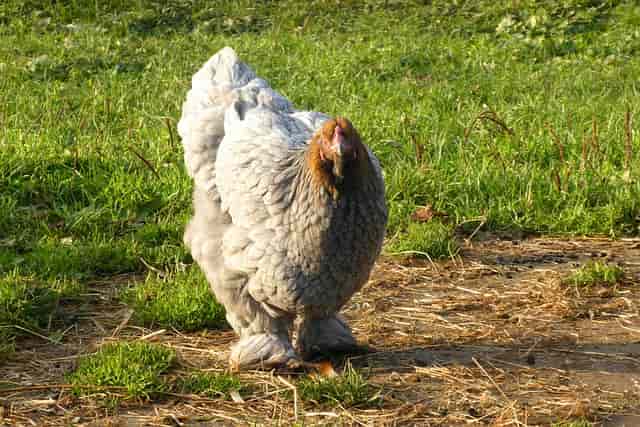
For most people, chickens aren’t the first animal that pops into mind when they think about a “pet”. Chickens are generally associated with farm animals and most people who keep chickens, keep them for their eggs.
However, this doesn’t mean that they are bad pets and despite the stereotype of chickens being stupid and boring, chickens are lovely to keep. They are great with kids, they bring character and life to the garden, and they can actually save you some money in the long term which not a lot of pets can do!
We’ve kept chickens since we were kids and there are some chickens breeds which are amazing pets and others that you should avoid. These are our favorite chicken breeds if you want to keep them as pets:
| Breed | Features |
| Silkies | Friendly and quiet but loves being around people, very small and has low egg production |
| Plymouth rock | Docile and inquisitive, very hardy with decent egg production |
| Cochin | Friendly but they tend to lazy, can often struggle with their weight |
| Brahma | Calm demeanor, friendly, and very large |
| Austrolop | Prolific layer and quite large with a calm demeanor |
| Buff Oripington | Dual-purpose hen, large, friendly, and tolerant |
| White Sussex | Large with black and white colouration, suited for free-range |
| Jersey Giant | Very large and friendly. It also produces large eggs |
| Wyandotte | Grows fairly large and is well suited for free-range |
| Polish | Prominent feathers with unique colouration |
| Rhode Island Red | Inquisitive nature, very hardy and medium-sized |
Silkies
| Eggs per year: 80-120 | |
| Egg colour: Light cream/brown | |
| Colour: White fluffy feathers with black skin | |
| Features: – Great temperament – Small – Low egg production |
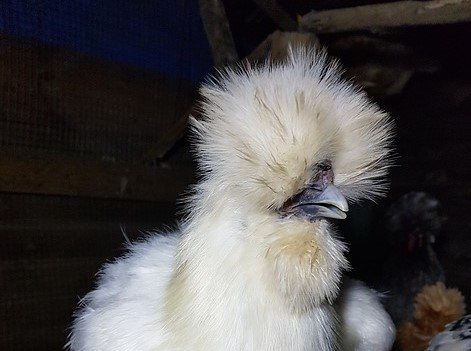
Silkies are one of the most popular chicken breeds to keep as pets and for good reason, they are adorable!
They are really fluffy, small, and love being around people. They have such good natures and because of their peculiar yet cute looks, kids love them. They also have little blue earlobes, but other than that, they are covered in fluff.
In terms of egg production, Silkies aren’t exactly what you would call a prolific layer, they’ll layer around 80-120 eggs per year which is substantially lower than most of the other chickens on this list. But that isn’t the reason why anyone would buy a Silkie, they’re a pet first and foremost and with such amazing looks, who cares about egg production!
Another interesting feature of the Silkie is that its skin, unlike regular chickens, is completely black. They are thought to have come from China and were originally named because of their black bones and skin.
Although Silkies have amazing temperament and love being cuddled and carried, they aren’t the hardiest birds. They also often have issues with lice because of their thick feathers, and must be kept out the rain, this can lead to the chicken freezing in cold climates.
The Silkie is a chicken that needs to be pampered and protected, its a bit of an oddball, but it will always turn heads and provide plenty of entertainment for children.
Plymouth Rock
| Eggs per year: 200 | |
| Egg colour: Brown | |
| Colour: Black, grey, and white | |
| Features: – Hardy – Calm, docile, sweet personality – Decent egg-production |
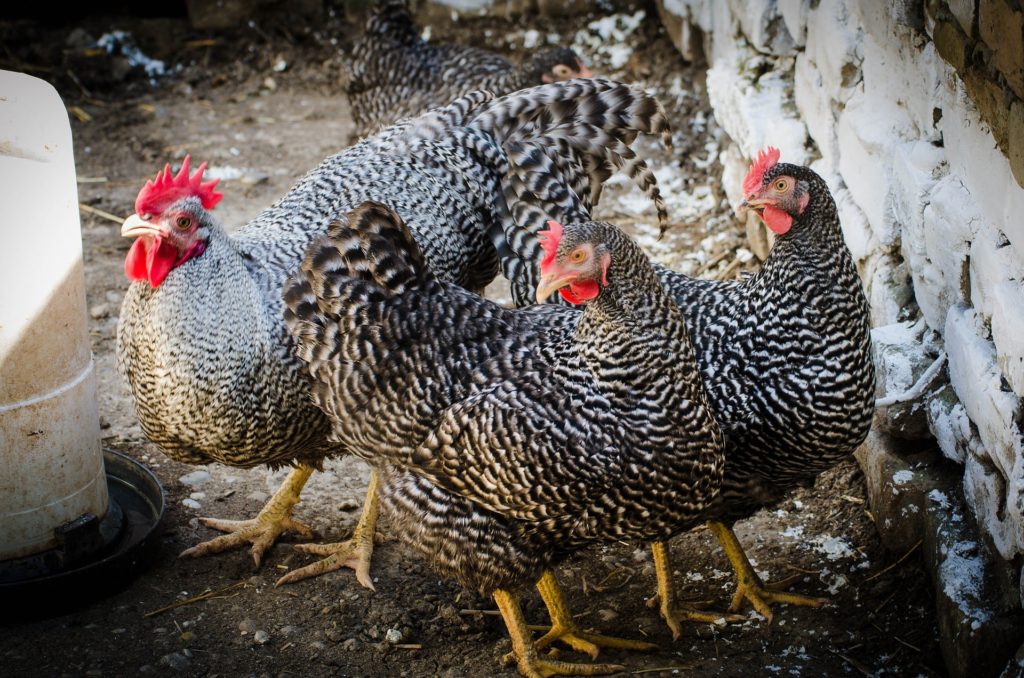
The Plymouth Rock is a lovely bird, they have a good temperament and are friendly around humans, making them an ideal pet. They are quite inquisitive and aren’t afraid to explore, we’ve kept several over the years, not only because of their personalities but also becuase of their egg production.
They lay a respectable 200 eggs per year. They were originally bred as a dual-purpose bird, for meat, and for eggs. We’ve never eaten one but the eggs they produce are delicious, they have deep golden yolks and creamy whites. Once you’ve tried eggs from your own hens, you’ll never want to go back.
Another reason why Plymouth Rocks are such as great pets is because they are a tough and hardy bird and they tend to live for quite a while. However, as with any chicken, their egg production will substantially drop as they get older.
Cochin
| Eggs per year: 160 | |
| Egg colour: Brown | |
| Colour: Varies/multiple colours | |
| Features: – Calm – Large – Slow and tend to be lazy |

The Cochin is another fluffy breed, similar to the Silkie they are covered in soft feathers. However, unlike the Silkie, they are large birds and their feathers extend right to their feet which makes them easily recognizable.
Cochins are usually quite mellow, lazy hens. They won’t run around curiously and they can hardly fly, making them very easy to contain. Their personality makes them good pets, they are comfortable and calm around humans and even the males rarely become aggressive. Kids will love Cochins as well, they’ve got a strange but cute appearance as they are draped in loads of fluffy feathers. They’re basically a big fluffy chicken!
A downside is that Cochins aren’t very good layers. A 150/160 eggs per year is pretty normal anything more than that is better than average. The eggs are brown in colour and medium sized.
Cochins are usually quite hardy, healthy birds. However, they do often struggle with their weight. You’ll often find that if they aren’t monitored, they can become overweight. To prevent this, its a good idea to measure their portions becuase too much food can have damaging effects on their health.
Brahma
| Eggs per year: 150 | |
| Egg colour: Brown | |
| Colour: Varies | |
| Features: – Very large |

The Brahma is another big, fluffy, heavyweight bird. With a thick plumage of feathers, it certainly has a presence and is a real head-turner. Similar to the Cochin, they too come in a variety of shades, their colouration is very pretty and complex.
Although their size can be intimidating, the Brahma is actually a very calm and docile bird, they can be handled very easily and they tend to be good around humans and children.
Due to all the feathers, the Brahma is perfect for living in cold climates, however, it can be dangerous for them to live in wet environments because of the number of feathers they have all over their body which can cause issues when wet.
The Brahma’s egg production is poor, they only produce around a 150 eggs per year, however, the eggs do tend to be reasonably sized. If its eggs you’re after, the Brahma isn’t a great option.
Most of the time, the Brahma is a hardy, robust bird. But due to the excessive feathers they can often suffer from lice, like the Cochin. Their feet also need extra attention if they live in a wet climate, if their feet remain wet, they can get frostbite and other Issues. But for the most part, they’re robust and healthy.
Austrolop
| Eggs per year: 250 + | |
| Colour: Black | |
| Egg colour: Brown | |
| Features: • Heavy-weight bird • Prolific egg layer |

The Austrolop is another egg-laying machine, its a very prolific layer and unlike some species, its egg-laying doesn’t deteriorate during the winter. Its also a large bird and is fairly calm, it tends to get on well within small spaces, however, they will prefer a free-range environment due to their rather inquisitive nature. They get on really well with humans and love company making them the ideal pet.
Another great feature of the Austrolop is their robustness, they rarely get sick and aren’t affected by anything unusual but they’re still susceptible to all the normal stuff like parasites and other minor chicken Issues.
The eggs that the Austrolop produces are also fairly standard, they’re of medium size and a light brown colour. To summarise, its a fairly high production hen with average eggs.
Buff Orpington
| Eggs per year: 200 | |
| Egg colour: Brown | |
| Colour: Light orange | |
| Features: – Dual-purpose hen – Large – Friendly and tolerant |

The Buff Orpington is another heavyweight bird, with a broad stature, considerable size, and a thick plumage of feathers. They love attention and the company of humans so don’t be surprised if they start following you around.
They’ve got calm personalities and most of the time, they’ll plod around the run quietly. Although their size is slightly imposing, they love being petted and cuddled, kids might be a little scared when they first see a Buff Orpington but they are really gentle giants and they rarely become aggressive.
They were originally bred to be dual purpose bird, which is why the are quite good layers and have substantial meat on their frame. As well as this, they deal with confined spaces well and they can be kept as free range.
It was originally thought of as the perfect dual-purpose bird but there’s no reason it can be the perfect pet.
White or Light Sussex
| Eggs per year: 200 | |
| Colour: White with black marking around the chest | |
| Egg colour: Brown | |
| Features: • Large • Attractive black and white colouration • Suited well for free-range |
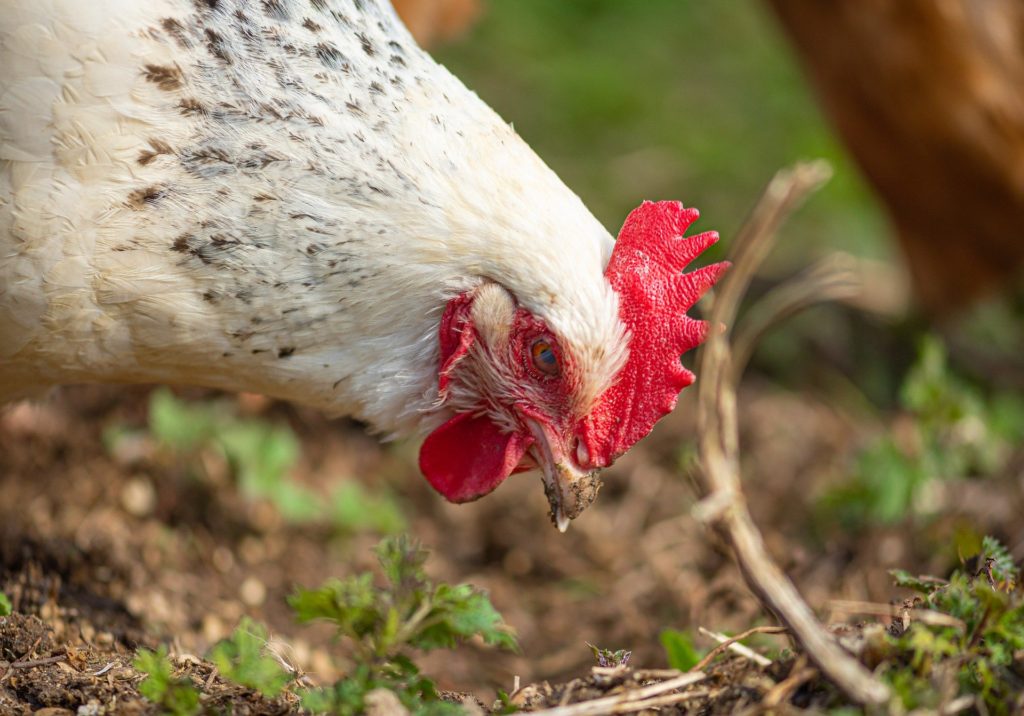
The white or light Sussex has a lovely nature, we’ve been keeping them for over ten years and despite them not being particularly productive layers, we still end up buying some every time we get a new flock.
They have such a good temperament and are friendly with children. The White Sussex also gets used to being held and eventually they start to enjoy human company. They’ve also got lovely personalities and are quite inquisitive, so don’t be surprised if you find them rummaging around in the garden.
However, they aren’t foolish and they are aware of their surroundings, so make sure to give them freedom and space when they first move in, as you would with any chicken, before getting too friendly with them. They adapt quickly to new environments so within a few days they should be comfortable with people around.
A White Sussex also has beautiful colours, they are primarily white with streaks of black around the chest and neck area. As well as this they tend to integrate well in a flock and are very hardy which makes them a brilliant pet.
Overall, they’re a brilliant pet and provide a decent amount of eggs per year. I wouldn’t call them prolific layers, but they produce a substantial amount of eggs (about 200 per year).
You can check out my full guide here
Jersey Giant
| Eggs per year: 220 | |
| Egg colour: Light brown | |
| Colour: Black | |
| Features: – Very large – Decent laying – Gentle You can check out my full guide here |
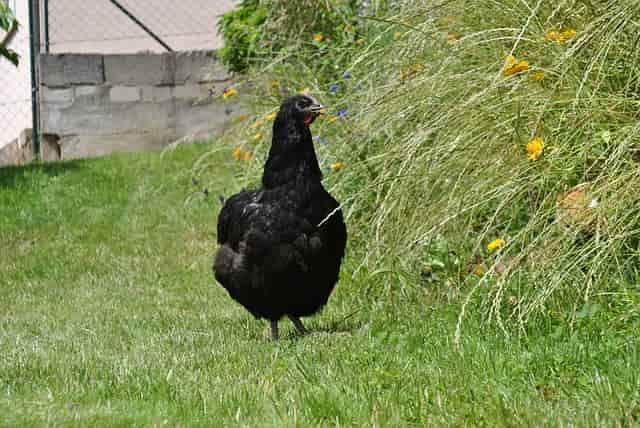
First of all, the Jersey Giant definitely lives up to its name because it is huge! The Brahma is the only other breed that comes close, its easily one of the largest, if not the largest breed in the world which is one of the reasons it’s so desirable.
Despite their imposing and slightly intimidating stature, the Jersey Giant is usually a big softy. They are docile, calm, and usually quite good around children which why they are such a good pet.
The eggs that the Jersey Giant lays are the like the chicken itself, very big. They aren’t the most prolific layers with around 200 eggs per year, but its still a very respectable figure for a dual purpose bird. The meat they produce is also said to be of high quality, and because of their considerable size, there is a lot of it!
Wyandotte
| Eggs per year: 200 | |
| Egg colour: Brown | |
| Colour: Varies | |
| Features: – Large – Suited well for free-range |
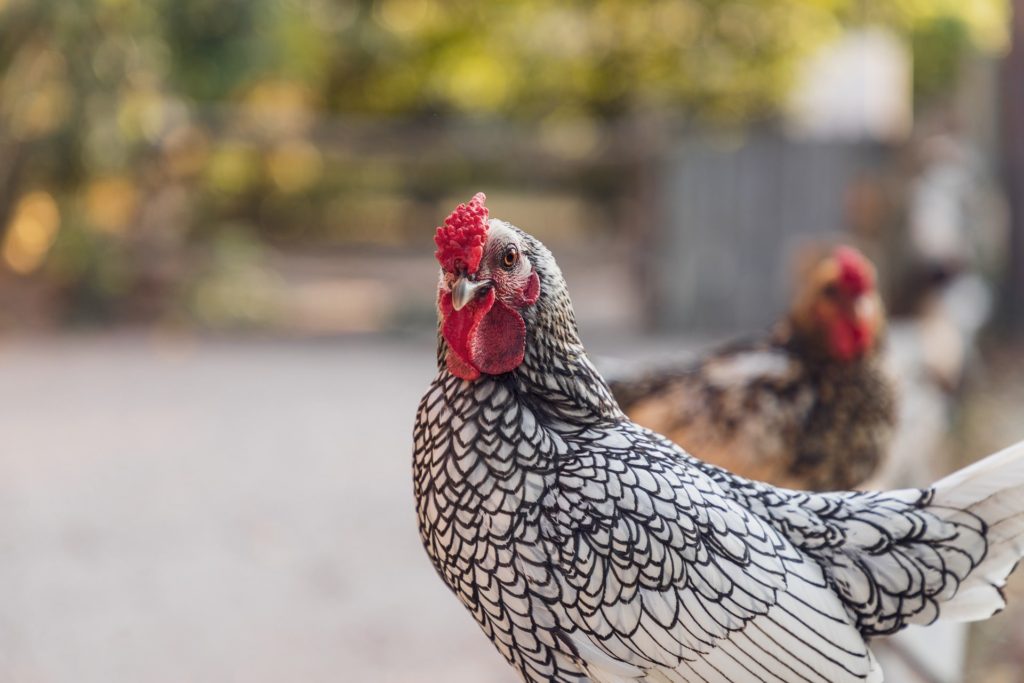
The Wyandotte is another great dual-purpose bird, like a lot of the birds on this list, it is a heavyweight and can grow up to around 8lbs. Its got a broad structure and most notably, absolutely beautiful markings, it one of the prettiest birds of this list, if not the prettiest.
Wyandottes tend to be quite docile as well, they’ll be friendly around humans as well and love being fussed over which is perfect for children. However, you may notice that they like to bunch together with their own kind in a flock and they won’t stand bullying from other birds as they are high in the pecking order.
They can deal with confined spaces fairly well but they will prefer free-range as they like to rummage around to look for food. Wyandottes are also fairly good at producing eggs, they’ll give around 200 brown eggs per year.
Polish
| Eggs per year: 170 | |
| Egg colour: white | |
| Colour: varies | |
| Features: – Prominent feathers – Unique colouration – Calm |
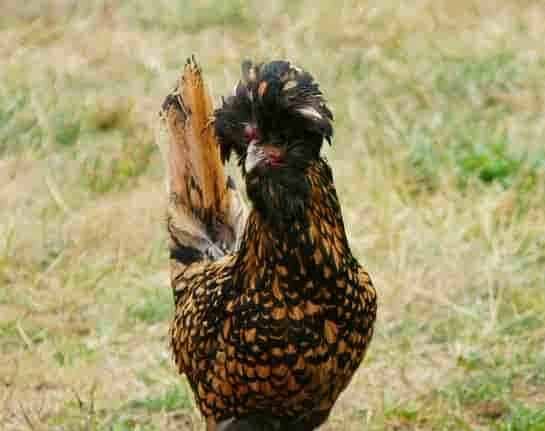
The Polish breed has always been primarily kept as a pet, due to their stunning colouration and odd look, they’ve always been a good option. As well as their adorable looks, the polish is friendly, quirky chicken that likes the company.
A Polish chicken is always easy to recognize, with a “poofy” Afro, they stand out from a mile away and children love them for their strange looks and personality,
In terms of egg production, the Polish vary quite a lot but a rough estimate is around 170 eggs per year which is pretty low. If you want a prolific layer that can be also kept as a pet, we’d recommend something like a Rhode Island Red. You can also check out our article on the best chicken breeds for egg production for more information.
Rhode Island Red
| Eggs per year: 250 | |
| Colour: Red/Dark orange body | |
| Egg colour: Brown | |
| Features: Prolific layer Curious Temperament Medium-sized |
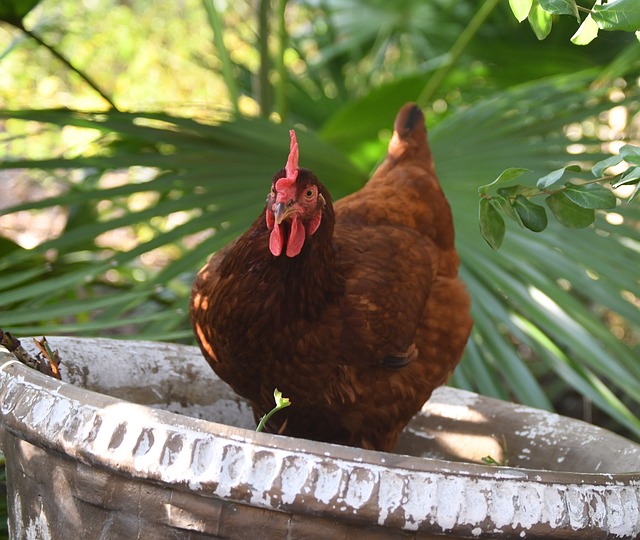
The Rhode Island Red is a very popular bird in the world and for good reason, the Rhode Island Red has thrived as being a modem Industrial hen due to its desirable characteristics. As well as its prolific egg production, the Rhode Island Red doesn’t need much care and attention and is incredibly hardy making it Ideal for first time hen owners.
However its efficiency isn’t the only thing that has made it one of the most popular breeds of chicken in the world, the Rhode Island Red has gorgeous colourations best described as deep, rich mahogany. As well as it’s stunning looks, the Rhode Island Red is a real character, they’re not bad-tempered but they’re not exactly docile either, they have a cheeky kind of character and they’re quite inquisitive as well. They’re awesome for slightly older kids but the odd peck from one of these hens should be expected.
When it comes down to egg production, the Rhode Island Red won’t fail to impress in this aspect either, they lay around 250 eggs per year of which are medium-sized and light brown. These hens originally got their high egg production from post world war II when the most prolific layers of the Rhode Island species were bred to Industrialize them which caused a difference between laying Rhode Islands and “Heritage” ones.
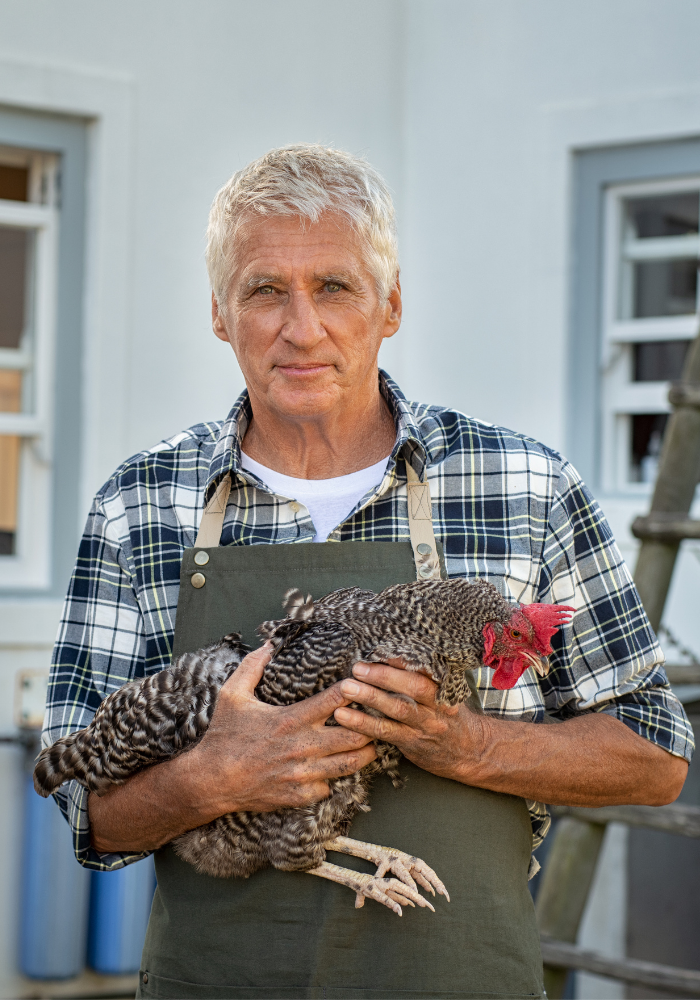
David Cameron is a passionate chicken enthusiast. Growing up, he always wanted to be a veterinarian and loved animals. After graduating from veterinary school, David spent over 40 years as an equine veterinarian. He and his wife retired a few years ago and moved to North Carolina. Here, David’s love of chickens grew even more – he now has 7 chickens and 6 quail. If you have any questions about chickens, feel free to reach out.

1 thought on “Best chicken breeds to keep as pets – 11 Amazing breeds”
Comments are closed.